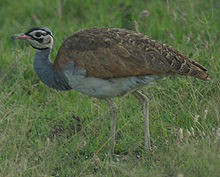White-bellied Bustard
| White-bellied Bustard | |
|---|---|
 | |
| E. s. canicollis, male, Sweetwaters Game Reserve, Kenya | |
| Conservation status | |
 Least Concern (IUCN 3.1) | |
| Scientific classification | |
| Kingdom: | Animalia |
| Phylum: | Chordata |
| Class: | Aves |
| Order: | Gruiformes |
| Family: | Otididae |
| Genus: | Eupodotis |
| Species: | E. senegalensis |
| Binomial name | |
| Eupodotis senegalensis (Vieillot, 1820) | |
| Synonyms | |
Eupodotis barrowii
Eupodotis caffra | |
The White-bellied Bustard or White-bellied Korhaan (Eupodotis senegalensis) is an African species of bustard.
Range and habitat
It is found in Angola, Benin, Botswana, Burkina Faso, Cameroon, Central African Republic,Chad, Republic of the Congo, Democratic Republic of the Congo, Ivory Coast, Eritrea, Ethiopia,Gabon, Gambia, Ghana, Guinea, Kenya, Lesotho, Mali, Mauritania, Namibia, Niger, Nigeria,Senegal, Somalia, South Africa, Sudan, Swaziland, Tanzania, Togo, Uganda, and Zambia. It lives in various habitats from grassland to open woodland.
Description
It is rather small for a bustard, 48 to 61 centimetres (19 to 24 in) long. All are tawny brown above and on the breast and white on the belly, with cream-coloured legs; juveniles have light brown necks and heads, and adults have blue-grey necks. The adult female has a grey crown, a brown and buff line below the eye, and black speckling on the throat. The adult male has a black crown, black lines on the white cheeks, a black throat patch, and a pinkish-red bill. The call, often given in the early morning and late evening, has been described as "a very loud, gutturalk'whuka WHUKa, k'wuka WHUKa..., or k'warrak, k'warrak...
This species is usually seen in pairs or family groups, as young stay with their parents much longer than those of other bustards in the region.
Subspecies
Five subspecies are recognized:
- E. s. senegalensis (Vieillot, 1820) – southwestern Mauritania and Guinea, east to Central African Republic, central Sudan, and perhaps Eritrea (Senegal Bustard)
- E. s. canicollis (Reichenow, 1881) – Ethiopia south to northeastern Tanzania
- E. s. erlangeri (Reichenow, 1905) – southern Kenya and western Tanzania
- E. s. mackenziei C.M.N. White, 1945 – eastern Gabon and central Democratic Republic of the Congo to Zambia, Angola and northern Namibia
- E. s. barrowii (J.E. Gray, 1829, sometimes considered a distinct species) – Botswana, South Africa, Swaziland and Lesotho(Barrow's Korhaan)


No comments:
Post a Comment